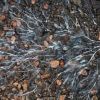-
 +3 +1
+3 +1SpaceX gives us a glimpse of its Mars base vision
SpaceX chief Elon Musk has tweeted two photos that give us a peek into the company's Martian dreams. One of the images shows the BFR, the massive rocket SpaceX is developing for deep space missions, while the other shows the BFR and what he called "Mars Base Alpha." It's no secret that the private space corporation wants to build a human settlement on the red planet. Back in 2017, it announced its plans to launch two BFR cargo missions to Mars by 2022 to prepare for the arrival of the first Martian settlers by 2024. Before any of that can happen, though, SpaceX has to be able to start testing its BFR system in the first half of 2019.
-
 +1 +1
+1 +1Rover Team Confident Curiosity Will Bounce Back from Glitch
It's still unclear exactly what's ailing NASA's Curiosity Mars rover, but mission team members are optimistic they can get the six-wheeled robot up and running again. Since last Saturday night (Sept. 15), Curiosity has had trouble beaming home to Earth certain science and engineering data stored in its memory. Curiosity has stood down from all science operations while the mission team investigates the problem.
-
 +12 +2
+12 +2Ancient Mars had right conditions for underground life, new research suggests
A new study shows that the breakdown of water molecules trapped in ancient Martian rocks likely produced enough chemical energy to sustain microorganisms for hundreds of millions of years beneath the Red Planet’s surface.
-
 +29 +4
+29 +4How Will Police Solve Murders on Mars?
Mars P.D. will have to deal with new blood-spatter patterns, different body decay rates, and space-suit sabotage—and they won’t be able to fire guns indoors. By Geoff Manaugh.
-
 +19 +5
+19 +5Curiosity Rover to Temporarily Switch 'Brains'
Engineers at NASA's Jet Propulsion Laboratory in Pasadena, California, this week commanded the agency's Curiosity rover to switch to its second computer. The switch will enable engineers to do a detailed diagnosis of a technical issue that has prevented the rover's active computer from storing science and some key engineering data since Sept. 15.
-
 +14 +2
+14 +2Mars scientists push NASA to send rock-harvesting rover to two sites
NASA’s next Mars rover — the first to gather rock samples meant to come back to Earth — should dream big and visit as many places on the red planet as possible, scientists concluded on 18 October. Its stops would probably include some combination of Jezero crater, once home to river deltas and a lake; Northeast Syrtis, which contains some of the most ancient rocks on Mars; and Midway, a compromise option located between those two. Project scientists have proposed visiting both Jezero...
-
 +19 +3
+19 +3Mars May Have Enough Oxygen to Sustain Subsurface Life
In recent years, Mars has looked more and more like a place where past life might have flourished. Now, some researchers believe the Red Planet may have the ingredients for life to exist in the present. You just have to go underground. In research published today in Nature Geoscience, a JPL-led team looked at the amount of oxygen in Martian soil, and their findings were influenced by two key recent discoveries. First, the Curiosity rover had found rocks on Mars that were heavily oxidized, possibly the result of water permeating into the rocks. Second is the recent research that revealed sources of briny water on Mars.
-
 +13 +1
+13 +1Oxygen-Rich Liquid Water May Exist on Mars
The possibility of life on Mars may not be consigned to the distant past. New research suggests our neighboring world could hide enough oxygen in briny liquid water near its surface to support microbial life, opening up a wealth of potentially habitable regions across the entire planet. Although the findings do not directly measure the oxygen content of brines known to exist on the Red Planet, they constitute an important step toward determining where life could exist there today.
-
 +22 +5
+22 +5Mars could have enough molecular oxygen to support life, and scientists figured out where to find it
Modern-day Mars may be more hospitable to oxygen-breathing life than previously thought.
-
 +14 +2
+14 +2NASA to soon end active efforts to restore contact with Opportunity
NASA expects to soon end efforts to contact the Opportunity Mars rover, silent for more than four months after a major dust storm, but will continue to listen for signals from the spacecraft for months to come. Opportunity, which has been on Mars since January 2004, last contacted Earth June 10. A powerful globe-spanning dust storm blocked the sun and deprived the rover of solar power, putting it into a low-power mode.
-
 +16 +4
+16 +4A Volcanic Eruption on Mars? Nope.
A photograph from a spacecraft orbiting Mars shows a long, white wisp, close to a thousand miles long, spilling out of a giant volcano. Could the volcano, thought to be dormant for some 50 million years, be about to blow? Planetary scientists confidently say no. “It’s just a cloud,” said Eldar Noe Dobrea, a scientist at the Planetary Science Institute, which is based in Tucson, Ariz.
-
 +19 +2
+19 +2Scientists call for ‘mega-mission’ to find ancient life on Mars
Rocket scientists tell Nasa a new rover could finally unlock red planet’s secrets
-
 +20 +3
+20 +3NASA launches Mars podcasts
All the thrills and spills of the latest mission to the Red Planet are now downloadable. Brian W. Pulling reports.
-
 +14 +3
+14 +3How fungus and sweat could transform Martian exploration
As a product designer imagines a Martian boot made out of human sweat and fungus, her quest sparks a new question: can biomaterials open the door for a human colony on Mars?
-
 +24 +2
+24 +2Organic carbon on Mars come from natural “batteries”
A new analysis of Martian meteorites indicates that the organic carbon on Mars may have come from naturally-occurring “batteries.”
-
 +10 +2
+10 +2NASA is working on a nuclear fission system that could help humans reach Mars
A small, lightweight fission system could help spacecraft travel huge distances.
-
 +17 +4
+17 +4How NASA Will Use Robots to Create Rocket Fuel From Martian Soil
The year is 2038. After 18 months living and working on the surface of Mars, a crew of six explorers boards a deep-space transport rocket and leaves for Earth. No humans are staying behind, but work goes on without them: Autonomous robots will keep running a mining and chemical-synthesis plant they’d started years before this first crewed mission ever set foot on the planet. The plant produces water, oxygen, and rocket fuel using local resources, and it will methodically build up all the necessary supplies for the next Mars mission, set to arrive in another two years.
-
 +4 +1
+4 +1This is what a sunrise on Mars sounds like, according to a computer algorithm
Scientists know a lot about Mars, at least when it comes to what it looks like. Sound, on the other hand, is a lot more challenging, and it’s not like we have high-powered microphones listening to the wind sweep across the Martian plains. Now, researchers from Anglia Ruskin University and the University of Exeter have created an interesting piece of music that wasn’t just inspired by Mars, but was actually composed by a computer algorithm using a Mars sunrise as data.
-
 +11 +3
+11 +3New Research Suggests Genetically Engineered Bacteria Could Transform Mars Into A Habitable Planet
Students at Exeter University have successfully demonstrated that genetically engineered bacteria could help to create breathable air on Mars when combined with perchlorate salts. Students from Exeter University have suggested that genetically engineered bacteria has the possibility to completely transform Mars and create a habitable planet that has breathable air after new research conducted in a lab showed that salts that can be retrieved from Martian soil could help to fuel this process.
-
 +19 +4
+19 +4NASA's Curiosity Rover on Mars Is Rolling (and Drilling) Again
After suffering a couple technical glitches that have put NASA's Curiosity rover off its duties on Mars this year, the robotic explorer seems to be back in full health, having driven to a new site and drilled a sampling hole, according to NASA statements. That hole is its 18th successful drilling assignment, according to NASA. It targeted a type of rock geologists with the mission have been eyeing for more than a month, but failed to successfully drill at a previous site. The drill was out of commission between late 2016 and this May as engineers addressed a problem with the instrument.
Submit a link
Start a discussion




















